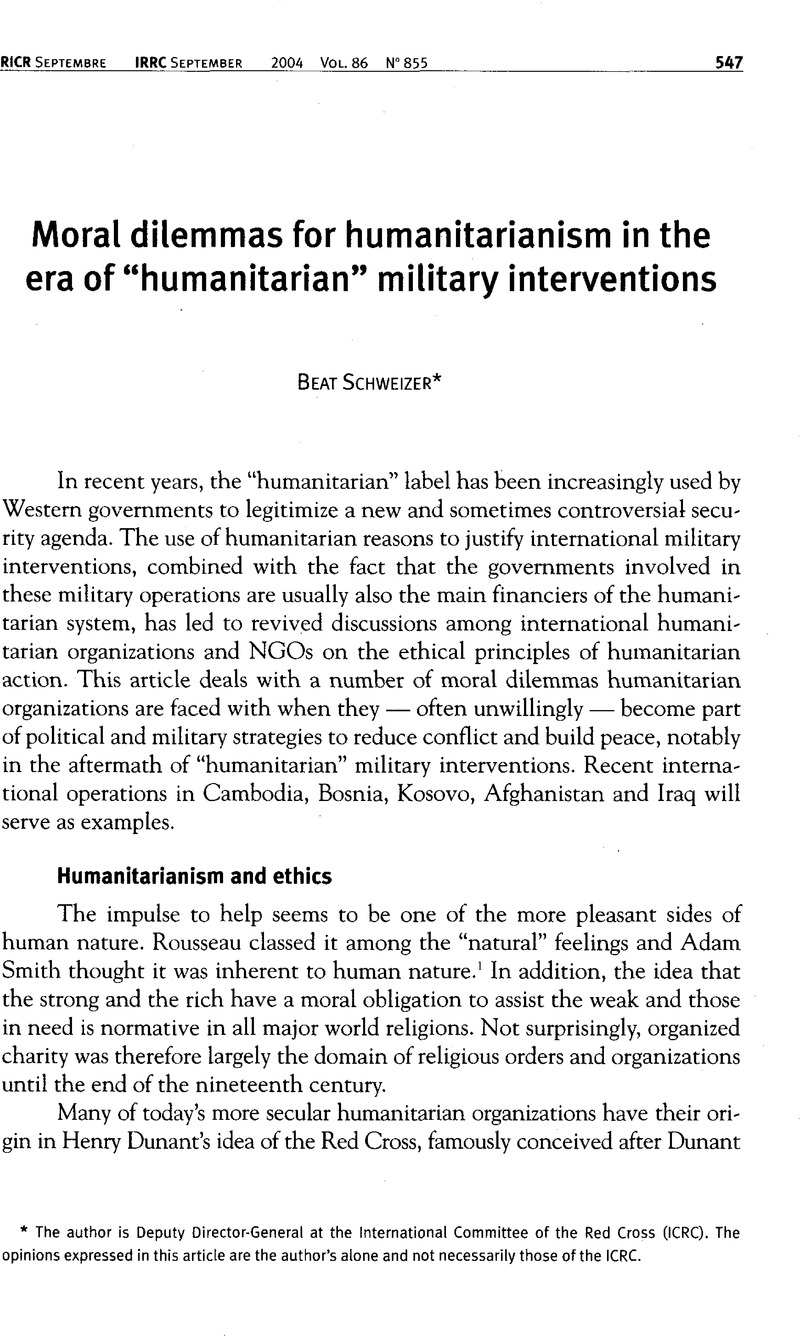Article contents
Moral dilemmas for humanitarianism in the era of “humanitarian” military interventions
Published online by Cambridge University Press: 27 April 2010
Abstract

- Type
- Research Article
- Information
- Copyright
- Copyright © International Committee of the Red Cross 2004
References
1 Rieff, David, A Bed for the Night: Humanitarianism in Crisis, Simon and Schuster, New York, 2002, p. 57.Google Scholar
2 Convention for the Amelioration of the Condition of the Wounded in Armies in the Field, Geneva, 22 August 1864.
3 Leader, Nicholas, The Politics of Principles: The Principles of Humanitarian Action in Practice, Humanitarian Policy Group Report No. 2, Overseas Development Institute, London, March 2000Google Scholar, available at <http://www.odi.org.uk/hpg/papers/hpgreport2.pdf> (last visited on 20 August 2004), p. 11.
4 Terry, Fiona, Condemned to Repeat: The Paradox of Humanitarian Action, Ithaca: Cornell University Press, New York, 2002, p. 17.Google Scholar
5 Moorehead, Caroline, Dunant's Dream: War, Switzerland and the History of the Red Cross, Harper Collins, London, 1998, pp. 29–32.Google Scholar
6 Ibid., pp. 155–215.
7 Luttwak, Edward N., “Give war a chance”, Foreign Affairs, Vol. 78, No. 4, July/August 1999, p. 43.CrossRefGoogle Scholar
8 Ibid., p. 44.
9 Anderson, Mary B., Do No Harm: How Aid Can Support Peace–or War, Lynne Rienner, Boulder, 1999, p. 2.Google Scholar
10 Terry, op. cit. (note 4), pp. 216–217.
11 Braumann, Rony, “L'assistance humanitaire internationale” in: Canto-Sperber, Monique (ed.), Dictionnaire de philosophie morale et politique. Presses Universitaires de France, Paris, 1996, p. 96.Google Scholar
12 Oxfam, Briefing Paper: An End to Forgotten Emergencies?, Oxfam, Oxford, May 2000Google Scholar, available at: <http://www.oxfam.org.uk/policy/papers/gemg/fgemgsum.htm> (last visited on 10 August 2004).
13 Macrae, Joanna, “Analysis and synthesis” in: Macrae, Joanna (ed.), The New Humanitarianisms: A Review of Trends in Global Humanitarian Action, Humanitarian Policy Group Report No. 11, Overseas Development Institute, London, April 2002Google Scholar, available at: <http://www.odi.org.uk/hpg/papers/hpgreport2.pdf> (last visited on 10 August 2004), p. 17.
14 Terry, op. cit. (note 4), p. 22.
15 Ibid., p. 20.
16 Rieff, op. cit. (note 1), p. 20.
17 International Committee of the Red Cross, “Frequently asked questions”, available at: <http://www.icrc.org/Web/eng/siteengo.nsf/html/faq> (last visited on 10 August 2004).
18 Quoted in Rieff, op. cit. (note i), p. 22.
19 Macrae, op. cit. (note 13), p. 7.
20 United Nations, “Report of the Panel on United Nations Peace Operations”, United Nations, New York, 1999, paras. 198–217, available at: <http://www.un.org/peace/reports/peace_operations/> (last visited on 10 August 2004).
21 Quoted in Rieff, op. cit. (note 1), p. 97.
22 Ibid., p. 66.
23 Ibid., p. 334.
24 Pugh, Michael, “Introduction: The ownership of regeneration and peacebuilding”, in: Pugh, Michael (ed.), Regeneration of War-Torn Societies, St. Martin's Press, New York, 2000, p. 3CrossRefGoogle Scholar.
25 Forman, Shepard and Patrick, Stewart, “Introduction”, in: Forman, Shepard and Patrick, Stewart (eds.), Good Intentions, Pledges of Aid for Postconflict Recovery, Lynne Rienner, Boulder/London, 2000, p. 1.Google Scholar
26 Stewart Patrick, “The donor community and the challenge of postconflict recovery” in: Forman and Patrick (eds.), op. cit. (note 25), p. 36.
27 Ibid., p. 37.
28 Rieff, op. cit. (note 1), p. 296.
29 Transitional Government of Afghanistan, Analysis of Aid Flows to Afghanistan, March 2003, available at: <http//:www.afghanistangov.org/resources/mof/cU-GoA-AidAnalysis.pdf> (last visited on 10 August 2004).
30 Rieff, op. cit. (note 1), p. 274.
31 Michael Pugh, “The social-civil dimension”, in: Pugh (ed.), op. cit. (note 24), p. 116.
32 Patrick, op. cit. (note 26), p. 39.
33 Sorpong Peou and Kanji Yamada, “Cambodia”, in: Forman and Patrick (eds.), op.cit. (note 25), p. 96.
34 Demichelis, Julia, NGOs and Peacebuilding in Bosnia's Ethnically Divided Cities, United States Institute of Peace, Washington, DC, June 1998Google Scholar, available at: <http://www.usip.org/pubs/specialreports/early/BosniaNGO.html> (last visited on 10 August 2004).
35 United States Institute of Peace, Unfinished Business in Afghanistan: Warlordism, Reconstruction, and Ethnic Harmony, United States Institute of Peace, Washington, DC, April 2003Google Scholar, available at: <http://www.usip.org/pubs/specialreports/sr105.html> (last visited on 10 August 2004).
36 Peou and Yamada, op. cit. (note 33), p. 96.
37 Zlatko Hertic, Amela Sapacanin, and Susan Woodward, “Bosnia and Herzegovina”, in: Forman and Patrick (eds.), op. cit. (note 25), pp. 350–353.
38 James K. Boyce, “Beyond good intentions: External assistance and peace building”, in Forman and Patrick, op. cit. (note 25), pp. 377–379.
39 Ibid., p. 379.
40 Demichelis, op. cit. (note 34).
41 Pugh, op. cit. (note 31), p. 123.
42 Ibid., p. 123.
- 10
- Cited by




